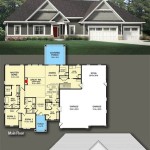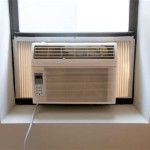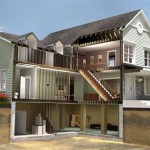Optimal Humidity Levels for a Finished Basement
Maintaining appropriate humidity levels in a finished basement is crucial for comfort, health, and structural integrity. Basements, by their nature, are often more susceptible to moisture problems than above-ground living spaces due to their proximity to the earth and potential for inadequate ventilation. When humidity levels are too high, mold and mildew can flourish, causing respiratory issues and damaging building materials. Conversely, excessively dry air can lead to discomfort and contribute to wood shrinkage and cracking. Determining the ideal humidity range and implementing strategies to achieve and maintain it are essential for a healthy and habitable basement environment.
The relative humidity (RH) is a measure of the amount of moisture in the air compared to the maximum amount of moisture the air can hold at a given temperature. It is expressed as a percentage. Monitoring RH is more informative than simply gauging moisture presence because it accounts for the relationship between temperature and humidity. Warm air can hold more moisture than cold air, so the same amount of water vapor will result in a lower RH at a higher temperature.
For a finished basement, the generally recommended relative humidity range is between 30% and 60%. This range is considered safe and comfortable for most individuals. Within this range, the risks of mold growth and other moisture-related problems are significantly reduced, while maintaining sufficient moisture to prevent excessive dryness. Staying within this range requires proactive management and consistent monitoring.
Understanding the Consequences of High Humidity
High humidity in a finished basement creates a breeding ground for mold and mildew. These fungi thrive in damp, dark environments and can grow on various surfaces, including walls, floors, carpets, and furniture. Mold not only damages building materials but also releases spores into the air, which can trigger allergic reactions, asthma attacks, and other respiratory problems in susceptible individuals. Black mold, in particular, is a concern due to its potential to produce mycotoxins, which can have more severe health effects.
Besides mold growth, high humidity can also lead to wood rot, corrosion of metal components, and damage to stored belongings. Wooden structural elements, such as floor joists and wall studs, can weaken and decay over time if exposed to prolonged moisture. Metal pipes, wiring, and appliances can corrode, potentially leading to costly repairs or replacements. Paper products, fabrics, and electronics are also vulnerable to damage from excessive moisture.
Furthermore, high humidity can create an uncomfortable living environment. The air feels heavy and clammy, making it difficult to regulate body temperature. This can lead to sweating and discomfort, especially during warmer months. The musty odor associated with mold and mildew can also make the basement less inviting and enjoyable to use.
Addressing the Risks of Low Humidity
While high humidity is a more common problem in basements, excessively low humidity can also pose challenges. In winter, when heating systems are in use, the air can become very dry. This can cause discomfort, such as dry skin, itchy eyes, and nosebleeds. Low humidity can also exacerbate respiratory problems, particularly for individuals with asthma or allergies.
Low humidity can also damage wooden furniture, flooring, and trim. Wood can shrink and crack when it loses moisture, leading to unsightly damage and potential structural issues. Musical instruments, especially those made of wood, are also susceptible to damage from low humidity. The dry air can cause the wood to warp or crack, affecting the instrument's sound and playability.
Static electricity is another common problem associated with low humidity. The dry air allows static charges to build up more easily, resulting in shocks when touching metal objects or other surfaces. This can be annoying and even painful in some cases. Static electricity can also damage sensitive electronic equipment.
Strategies for Maintaining Optimal Humidity
Several strategies can be employed to maintain optimal humidity levels in a finished basement. The specific approach will depend on the individual basement's characteristics, including its size, construction, ventilation, and climate. A combination of measures is often necessary to achieve the desired results.
One of the most effective methods for controlling humidity in a basement is using a dehumidifier. Dehumidifiers remove moisture from the air, reducing the risk of mold growth and other moisture-related problems. Choose a dehumidifier that is appropriately sized for the basement's square footage and humidity levels. Models with automatic humidistats can be set to maintain a specific humidity level, ensuring that the basement stays within the recommended range. Regular maintenance, such as cleaning the filter, is essential to keep the dehumidifier operating efficiently.
Adequate ventilation is also crucial for controlling humidity. Proper ventilation allows moist air to escape and fresh air to circulate, preventing the buildup of humidity. Ensure that the basement has sufficient ventilation, either through windows, vents, or a mechanical ventilation system. Window wells should be kept clear of debris to allow for proper airflow. A whole-house ventilation system or an energy recovery ventilator (ERV) can be installed to provide continuous ventilation while minimizing energy loss.
Proper insulation is essential for preventing condensation, which can contribute to high humidity levels. Insulating basement walls and floors can help to maintain a consistent temperature, reducing the temperature difference between the inside and outside surfaces. This reduces the likelihood of condensation forming on cold surfaces. Vapor barriers can also be installed to prevent moisture from migrating through the walls and floors. Ensure that the vapor barrier is properly installed to avoid trapping moisture inside the wall cavity.
Addressing sources of moisture is critical for controlling humidity. Identify and repair any leaks in the foundation walls or floor. Ensure that gutters and downspouts are properly functioning to direct water away from the foundation. Grading the soil around the foundation to slope away from the house can also help to prevent water from entering the basement. Consider installing a sump pump if the basement is prone to flooding or groundwater infiltration. A sump pump will automatically remove water from the basement, preventing it from accumulating and causing moisture problems.
Using a hygrometer to monitor humidity levels is important for proactive management. A hygrometer is an instrument that measures the relative humidity in the air. Place hygrometers in different areas of the basement to get an accurate reading of the overall humidity levels. Monitor the hygrometer readings regularly and adjust the dehumidifier or ventilation system as needed to maintain the desired humidity range. Some smart hygrometers can connect to a smartphone app, allowing for remote monitoring and alerts when humidity levels exceed the set threshold.
Finally, consider the impact of everyday activities on humidity levels. Activities such as showering, cooking, and washing clothes can generate significant amounts of moisture. Ensure that these activities are properly vented to the outside to prevent the buildup of humidity in the basement. Use exhaust fans in bathrooms and kitchens to remove moist air. Avoid drying clothes indoors if possible, as this can significantly increase humidity levels. If you must dry clothes indoors, use a dehumidifier to remove the excess moisture.

Here Is The Ideal Humidity For Your Finished Basement

Basement Humidity Levels Variations Impacts And Controling

Relative Humidity Why You Need To Understand It News And Events For Basement Systems Inc

Basement Humidity Levels Variations Impacts And Controling

Basement Humidity Levels Variations Impacts And Controling

Basement Humidity Levels Variations Impacts And Controling

Overview Dehumidification In The Basement Or Crawl Space

Basement Humidity Levels Variations Impacts And Controling

How To Lower Your Basement S Humidity Level

Solving Excess Basement Humidity Petrole Page
Related Posts







